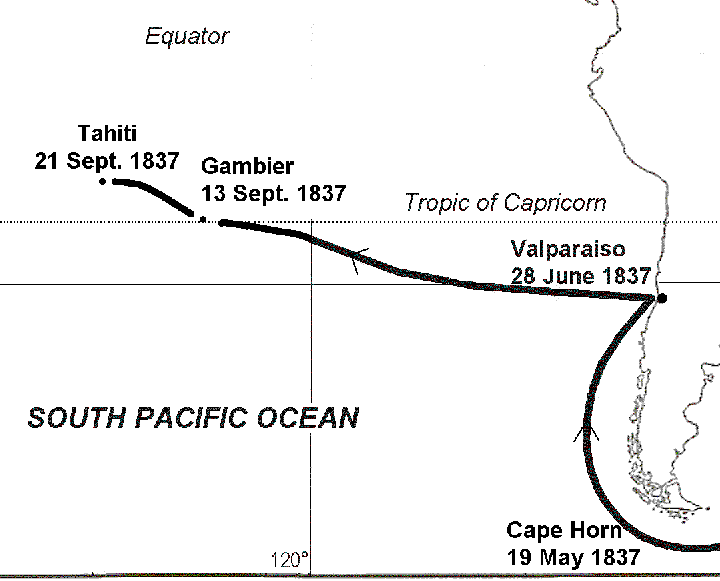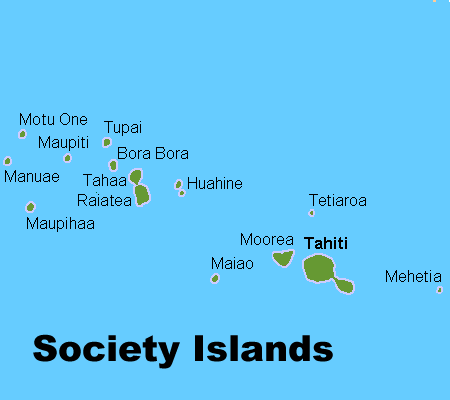APAC59
From Marist Studies
Tahiti
- Everybody expected that Catholic missionaries would not be allowed ashore in Tahiti. On instigation by George Pritchard, of the London Missionary Society, the Fathers Caret and Laval had been expelled in December 1836, and Caret and Maigret again in January 1837.[1] Still, on 16 September, after only a few days in the Gambier Islands, encouraged by recent information, the Europa set sail for Tahiti for a commercial call. They arrived around noon on the 21st and the ship was allowed to enter port. Thanks to the intervention of Mr. Jacob Moerenhout, a Belgian trader on the island who also functioned as American consul,[2] Pompallier and his men were allowed to move about freely, and by displaying full purple he drew large crowds. Queen Pomare Vahine IV was curious enough to invite Pompallier to the palace and her charm made him think that she and many people with her would have liked the re-presentatives of the true Church to stay. Having been expelled already once, Maigret who was set to sail with the Marists in a new attempt to get into Hawaii, and Columban Murphy, who for that same purpose had secretly been ordained a priest by Rouchouze during their stay in Mangareva, prudently stayed on board.[3]
- The Marists visited Moerenhout regularly, and Pompallier said Mass in the privacy of his home. He also baptised and confirmed the seven-year-old son of the third officer of the Europa. The boy, baptized Jean-Marie, was born in New Zealand but had been brought up in Tahiti. Pompallier felt elated at this first baptism of a New Zealand born child: the first fruits of New Zealand, les prémices de la Nouvelle Zélande.[4]
- Pompallier was very appreciative of the reception he received from Moerenhout. He recommended him to the Director of the Colonies at the Ministry of the Navy in Paris for an appointment as consul of France. After Moerenhout was dismissed as consul for the United States he was indeed appointed consul of France, first in Tahiti, later in California.[5]
- The stay in Tahiti turned out to be a godsend. This time Pompallier heard less favourable reports on Hawaii, and more favourable ones on Tonga, Samoa, Fiji and New Zealand both from Moerenhout and from Captain Stocks who had sailed all over the Pacific for years. Moerenhout had recently been able to purchase a small schooner, the Raiatea. He offered it to Pompallier for 400 piastres a month, to go wherever he wanted under Captain Stocks, and to keep it for as long as he needed it. The missionaries were to look after their own provisions. In Valparaiso Pompallier had abruptly changed his plans; in Tahiti he did it again. After consulting the confreres he now decided to forget about Hawaii and go straight to Pohnpei that captain Stocks knew well; and from there via Sydney to New Zealand! He did not get a refund from the fare he already had paid as far as Hawaii, but, as he wrote to Cardinal Fransoni, in this way he avoided the cost of travelling from Hawaii to Pohnpei. He chartered the Raiatea on the conditions offered. He did not have enough money, and left owing Moerenhout several thousand piastres. The Europa with Captain Shaw in command, would continue to Hawaii with Maigret and Murphy as planned.[6]
- Chanel looked with diffidence at the Raiatea. He called it a méchante petite goélette, a nasty little schooner (only 60 tons), and without even a copper bottom! This time travelling was going to be very uncomfortable indeed. They took their luggage off the Europa and transferred it to the Raiatea.[7]
- After the favourable stories he had picked up about Tonga, Pompallier now decided to visit Vava`u first, and sail only then to Pohnpei in Micronesia. There he might leave some missionaries with Chanel in charge, and sail on to Australia and New Zealand himself. All of this news, with his change of plan and many interesting details, he communicated to Colin in a five-page letter from Tahiti, dated 2 October. He told Colin to forget about a procure, not only in Valparaiso, but also in California or Hawaii. By now it had become clear to him that Sydney was the only and the best place because of its frequent communications with Europe as well as with New Zealand and the islands. Moreover, in Australia one would find a civilized environment, an established church under a vicar apostolic and a Christian community protected by Great Britain.
- Pompallier foresaw that the next missionaries might still come the long way, around Cape Horn, in which case they should avoid Hawaii, where the situation was confused and opposition against Catholics had flared up again. Tahiti was the place to aim for, and if they were not allowed to land, they could always stay on the ship and Moerenhout would help them on their way. Moerenhout was also a reliable postal address. If they came around Cape of Good Hope, they could rely on Bishop Polding in Sydney for the necessary help.[8]
- He repeated his urgent request for reinforcements, and, having seen the Picpus men at work, he now insisted on Brothers as well as on priests. In two cases, Hawaii as well as Tahiti, the priests had been expelled but a Brother allowed to stay! He hoped Colin to be able to send at least four priests and three Brothers soon. He begged Colin also to plead his cause with the Propagation of the Faith. His funds were about exhausted. He was at his wit’s end on how to even begin the actual mission work.[9]
Notes
- ↑ Jore, op. cit., II, pp. 209 – 212 & pp. 219 – 226. Yarwood, A.T., Samuel Marsden: The Great Survivor, p. 266.
- ↑ Since 1830 Moerenhout was an important trader in Tahiti, importing shiploads of goods from France, cf. Jore, op. cit., I, p. 100. In July 1837 he had been dismissed by the American government on request of Queen Pomare, but the news was to reach Tahiti only in August 1838. Wiltgen, op. cit., p. 154. Jore op. cit., II, p. 233.
- ↑ LRO, 21 [8- 9]. EC, 38 [6 – 9]. Wiltgen, op. cit., p. 152. Pompallier, op. cit, p. 14. Rademaker, op. cit. p. 91.
- ↑ LRO, 21 [9]. EC, 38 [8].
- ↑ Pompallier to M. de Saint-Hilaire, Directeur des Colonies, 28.09.1837. Moerenhout became consul of France in Tahiti in September 1838, and later on in California. Jore, op. cit., II, p. 229 & 342.
- ↑ LRO, doc. 21 [10], Pompallier to Fransoni, 21.05.1838, ACPF, Congressi Oceania I, p. 485r. doc. 37 [5]. The Raiatea was at his service for about seven months, which amounted, not counting the provisions, to an expense of 2.800 piastres = 15.400 francs. What down payment he was able to make, we do not know.
- ↑ In the tropics the hulls of wooden ships need a copper lining to protect them against the so-called ship-worm, teredo navalis, that uses its shell to gouge holes into the wood of ship hulls and jetty posts (with thanks to captain L. Oosthuizen and Google). Br. Nizier later recalled this remark of Chanel. Cf. Ronzon, Delorme, p. 40.
- ↑ LRO, doc. 21 [10 - 15]. Jore, op. cit., I, p. 212; II, pp. 197 – 212.
- ↑ LRO, doc. 21 [10]. Pompallier, op. cit., p. 14.
| Previous Section | A Piety Able to Cope | Next Section |

